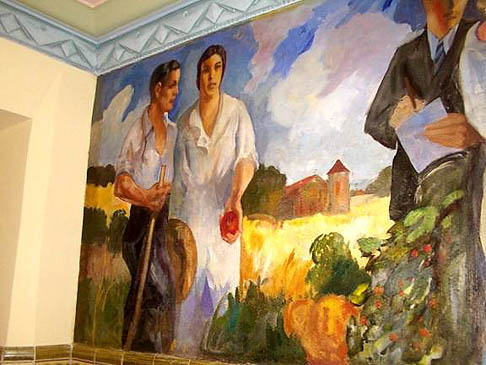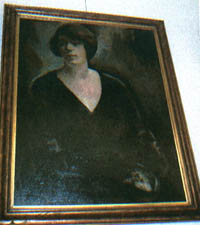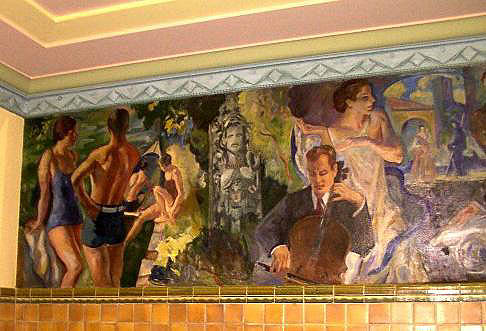
New Deal/WPA Art in Wauwatosa, Wisconsin
Wauwatosa (East High School) article by Ray Py:
UNKNOWN WAUWATOSA HS MURAL ARTIST WAS "LOST GENERATION" PAINTER OF JAMES JOYCE PORTRAITS
By Ray Py
Wauwatosa High School Class of 1954
After a four year search, I now know the name of the artist who painted two 14' by 4' oil-on-canvas murals at my high school, but mysteriously left them unsigned when he completed the work 70 years ago.

His name is Myron Nutting and in 1934 when he painted the canvases under a Federal Arts Program project at Wauwatosa (East) High School, he was an art instructor at the old Layton School of Art in Milwaukee.
But only a few years earlier, in the years he struggled as a young artist and student in Paris, Myron Nutting counted among his close personal friends, the most famous of the expatriated writers and artists of "the lost generation." Among them Irish writer James Joyce whose controversial first masterpiece novel, "Ulysses" was banned for 10 years in the United States, and Ezra Pound, an American poet held by U.S. military authorities in Rome as an alleged traitor during World War II
Besides Joyce and Pound, Nutting's Paris studio was a gathering place for dozens of young men and women who had become disillusioned at the materialistic world following World War I. Fleeing to Paris to live the bohemian lifestyle, they experimented in new and radical writing styles and subjects that challenged traditional artistic and literary establishments. As a result, Nutting's studio friends of "the lost generation" wrote and painted some of the finest literature and art to date. Perhaps the most famous member of the generation was Ernest Hemingway who was in Paris at the same time and was a close friend of Joyce and Pound. However, there is no evidence that he knew or associated with Nutting.
 |
Nutting's personal relationship with James Joyce, his wife Nora
and his family was intense, resulting in portraits he painted of each family
member. These art masterpieces can be found today in the special Joyce
collection at Northwestern University. Nutting's casual sketches in oil
and crayon of Joyce and others who met at his studio are frequently found
in museums or sold in important galleries throughout the world.
(portrait of Nora Joyce, wife of James Joyce, painted by the artist in about 1922) |
Joyce is known for his first novel, the masterpiece "Ulysses," which set the style for future writers. It was a story of one day-long journey through Dublin, Ireland, his hometown. Because of its new and controversial writing style and frank language, the book was banned in England and the United States for 10 years after it was published.
Ezra Pound, the expatriated American poet who aided Joyce with money and support while he worked on his manuscripts, was also a close Nutting friend. Controversial because of his anti-war views on the war, Pound made international headlines when he was detained by U.S. military authorities who attempted to have him declared a traitor for broadcasting anti-war messages to U.S. soldiers in Rome during World War II.. Another frequent guest at Nutting's studio parties was Sylvia Beach, an expatriate American poet who owned and operated Shakespeare and Company, a Paris book shop where such literary luminaries as T.S. Eliot and Ernest Hemingway were among her customers. Beach financed the publication of Joyce's "Ulysses," and was briefly interned by German occupation forces because she refused to sell a high ranking Nazi officer her last copy of the Joyce book.
 Nutting
was commissioned in June 1934 to design and paint the Wauwatosa High School
murals in the school's art-deco style front lobby. The murals hang on facing
walls, each in a space measuring 14 feet by 4 feet, above glazed tile walls.
In a modernization during the mid-1970s, the murals, tiles and two oak
trophy cabinets were covered over with plaster and wallboard. The heads
and shoulders on the murals were hidden under dropped ceilings that also
concealed wiring, piping and cables that were added during the modernization.
Nutting
was commissioned in June 1934 to design and paint the Wauwatosa High School
murals in the school's art-deco style front lobby. The murals hang on facing
walls, each in a space measuring 14 feet by 4 feet, above glazed tile walls.
In a modernization during the mid-1970s, the murals, tiles and two oak
trophy cabinets were covered over with plaster and wallboard. The heads
and shoulders on the murals were hidden under dropped ceilings that also
concealed wiring, piping and cables that were added during the modernization.
As a professional artist with the Federal Works Program in the mid-to-late 1930s, Nutting painted murals at Beaver Dam High School and for the Natural History Museum in Milwaukee before he was selected in June 1934, for the Wauwatosa project by Charlotte Russell Partridge, his boss at Layton and the director of the Federal Arts Program for Wisconsin.
The Wauwatosa mural had been requested in January 1934 by Wauwatosa school superintendent William T. Darling. Darling picked the two walls for the murals and suggested as subjects "a local landscape or a scene of old Wauwatosa." He authorized payment to the federal government of $75 for the cost of materials as the application suggested.
Nutting was born in Panaca, NV on Oct. 18, 1890 and worked as an instructor at Layton from 1929 to 1939 when he left the area for California. He died in Los Angles in 1972. His first wife, Helen, wrote poetry and kept journals of reminiscences of various friends, including Joyce and Pound during the couple's Paris years. Her poetry collections are on file in various libraries. She and her husband were with Joyce the night he celebrated the publication of "Ulysses" although he could only afford to have two copies of the book available at the dinner for guests to inspect.
Nutting studied at the University of Paris and the Julian Academy, as well as at the British Museum of Fine Arts. He painted murals at the Museum of Natural History in Milwaukee, at Beaver Dam and Wauwatosa high schools in Wisconsin, and in various locations in France. He held positions in art schools and institutes in Milwaukee, Los Angeles and San Antonio. His personal letters, art pieces, speeches and manuscripts are in a special Nutting collection at the University of California Library at Los Angeles. Among these are notes for an unfinished autobiography and manuscripts he intended to publish about literary figures, English writer Wyndham Lewis and playwright Elmer Rice, both contemporaries of "the lost generation."
Most of Nutting's professional life as an artist was spent in southern California. He was known to be critical of modern artists and was influential in the art community, serving even as an editor of an art publication where, in 1949, he wrote this editorial after covering an exhibition of young artists in Los Angles:
"American art, and possibly most of all California art, is somewhat open to criticism of being clever, "slick" and eclectic.
"Let us toss into the discussion this question: Is there any other country in which the young artist has to struggle against the influence of money-making mediocrity as with us? All about him, from childhood up, glamorous movies; women's magazines and interior decorators set the pace until it is a strong character indeed who does not develop a certain degree of anesthesia, whose maturity is not delayed, whose sensitiveness is not dulled."
In June 2002, 68 years after he began work on the Wauwatosa murals, Myron Nutting's work was again on display in the Milwaukee area. A 1932 Nutting pastel entitled simply "Herthe" was displayed with other Wisconsin artists at the Charles Allis Art Museum. The late James Auer, critic for the Milwaukee Journal/Sentinel praised the show artists for what he called "cross fertilization among historical disciplines." He said good art was often "tied in with all sorts of historical elements. . .," and cited Myron Nutting as an example:
"One thing you learn quickly when you begin to cover the visual-arts beat: Art history encompasses all of human history–military, economic, social, political and architectural. Or, put it another way, there's far more to the history of art than simply a succession of styles, periods or names.
"What broadens (Myron) Nutting's story, and causes it to intersect with avant-garde European literary history of the 20th century, is the fact that while he and his wife, Helen, lived in Paris in the 1920s, ...they became friends with the famous Joyce family of writers and members of their circle, including Ezra Pound and T.S. Eliot," the review stated. "Interesting? More than that. Revealing. And prophetic. Art was, of course, a vital element in all of these equations, but it wasn't the only one. Other kinds of history, made by people who weren't necessarily visual artists, enhance and enrich the total picture."
A major fund drive by alumni, current students and the community has successfully raised the $125,000 needed to fund the restoration work by artists, mural restorers and volunteers who removed more than 2,000 pounds of plaster from the murals, walls, and the oak and etched glass cabinets that braced the old main entrance to the Wauwatosa High School building (now called Wauwatosa East High School).
Inside the cabinets, the restorers found electric light bulbs still intact in the cabinet ceilings and electricity still flowing into the cabinets. Once the ancient bulbs were replaced, the lights shone brightly once again after 30 years of darkness. Mosaics above the oak and etched glass doors on both cabinets formed an image of an ancient Grecian athlete, indicating that the cabinets were used mainly as display space for the school's athletic trophies. Some red and white bunting representing the school's Cardinal and white colors, was intact on one of the glass shelves.
Tony Rajer, a University of Wisconsin art instructor and restoration artist who headed the restoration project, called the Wauwatosa murals one of the finest examples of school lobby art in the state of Wisconsin. He was hired to restore the murals and started the job in January 2003 and completed the work in October 2004. The lobby with its murals and glazed tile walls and floors, and the two cabinets will become a permanent historical center to alumni who have graduated from the school since its inception in 1871.
Under the dual partnership of the Wauwatosa School District and the Wauwatosa Historical Society, the murals will be formally dedicated to the public on March 6, 2005.
Wauwatosa High School was built under funding by the Works Progress Administration and was under construction from 1931 until 1941 when the auditorium was completed.
Ray Py
© 2005 Raymond Py
Contact the author:
Mr. Py invites your comments, questions, and inquires about the Wauwatosa murals. You can contact him directly at:
Ray Py
2450 N. 63 St.
Wauwatosa, Wi. 53213
414-453-6891
raypy@msn.com
Other articles about the Wauwatosa, WI High School murals:
"The Tosa High Project" - a webpage about the restoration project with additional photographs of the artwork and the rededication ceremony celebrating the completion of the restoration held Sunday, March 6, 2005 (pdf file 805kb of the Alumni Newsletters articles relating to the Wauwatosa mural restoration)
"Wauwatosa Senior High School Alumni Association," by Ray Py, Lowell Damon Woods Association, February 2003 - photo of the restoration in progress
"New
Deal-era treasure rediscovered Tosa East murals could become history lesson"
By WHITNEY GOULD, the Journal Sentinel, June 16, 2002
"WPA Mural Uncovered," Tosa Alumni New, Winter 2002
"Students protest over old mural," February 29, 2000 (references a different mural than the Myron Nutting mural)
© 2005 Nancy Lorance
All Rights Reserved.